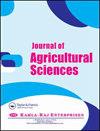The Effect of Maize (Zea mays L.) / Soybean (Glycine max (L.) Merr.) Intercropping and Biofertilizer (Azotobacter) on Yield, Leaf Area Index and Land Equivalent Ratio
IF 0.7
Q3 AGRICULTURE, MULTIDISCIPLINARY
引用次数: 3
Abstract
This study was conducted to determine the effects of the different intercropping design of maize/soybean compared with sole cropping, in combination with Vitormone (biofertilizer; Azotobacter) during 2012 and 2013. There were four different intercropping designs were used in the experiment: i) sole maize and soybean, ii) 1 maize + 1 soybean in alternate rows, iii) 1 maize + 2 soybeans in alternate rows and iv) 1 maize + 2 soybeans in intra rows under control with the Vitormone application. The experiment was laid out in a randomized complete block design with two factors and three replications. The results showed that the seed/grain yields and the Leaf area index of sole soybean and sole maize outperformed the intercropping. The highest yields for both maize (8.0 t ha-1) and soybean (3.26 t ha-1) and land equivalent ratio (1.26) were recorded at 1 maize + 2 soybeans in alternate rows among the intercropping. The effect of Vitormone was significantly positive for all cropping system except 1 maize + 1 soybean in alternate rows. This suggests that 1 maize + 2 soybeans in alternate rows can intercrop and combine with the Vitormone. The intercropping of cereal/legume has the potential to improve the utilization of resources in monocropped lands.玉米(Zea mays L.) /大豆(Glycine max (L.))的效应稳定)。间作与生物肥料(固氮菌)对产量、叶面积指数和土地当量比的影响
本试验旨在确定玉米/大豆不同间作设计与单作相比的效果,并结合使用维多酮(vitormonone)生物肥料;在2012年和2013年期间。试验采用4种不同的间作设计:1)单玉米+大豆,2)1玉米+ 1大豆,3)1玉米+ 2大豆,3)1玉米+ 2大豆,4)vitormonone控制下,1玉米+ 2大豆行内。试验采用双因素、3个重复的完全随机区组设计。结果表明,单作大豆和单作玉米的籽粒产量和叶面积指数优于间作。间作1玉米+ 2大豆交替行,玉米产量(8.0 t hm -1)和大豆产量(3.26 t hm -1)最高,土地当量比(1.26)最高。除1玉米+ 1大豆交替行外,维托莫酮对其他种植制度的影响均呈极显著正相关。说明1玉米+ 2大豆隔行间作可与vitormonone组合使用。谷物/豆类间作有可能提高单作土地的资源利用率。
本文章由计算机程序翻译,如有差异,请以英文原文为准。
求助全文
约1分钟内获得全文
求助全文
来源期刊

Journal of Agricultural Sciences
AGRICULTURE, MULTIDISCIPLINARY-
CiteScore
1.80
自引率
0.00%
发文量
0
 求助内容:
求助内容: 应助结果提醒方式:
应助结果提醒方式:


